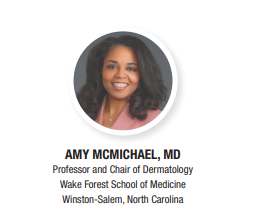With Amy McMichael, MD
Microaggressions can be intentional or unintentional slights, insults, or indignities on diversity-defining characteristics, such as race, gender, and religion. Verbal or nonverbal, they are not always obvious to others.

“I experience microaggression still today, but one of the times when a microaggression really affected me emotionally was when I was a resident. It was in the mid-1990s. I walked into an elderly Caucasian patient’s room. I was a senior resident in the clinic that day. I introduced myself and asked what his concerns were.
“He said, ‘I am not going to see you as a physician.’ He went on to say he was a teacher and did not believe in Affirmative Action.
“I walked out of the room and told my attending, my faculty mentor, and he said, ‘Well, you know, don’t worry about that person. That’s just stupid and he doesn’t understand. Just move on to the next patient.’
“He sent a first-year resident, a Caucasian male, into the patient’s room.
“I was so upset that I was shaking. There was no discussion of it later. There was no interest in going in and talking to the patient and saying this is not something we do in our clinic. No support, whatsoever.
“I have never forgotten that feeling. It was awful.
“Part of the reason I want to bring microaggression in medicine to light is I do not want people to feel like that. It affected me for the entire day. I have never forgotten the experience,” said Amy McMichael, MD, Professor and Chair of Dermatology at Wake Forest School of Medicine.
Microaggressions might occur less often nowadays, but they still happen and continue to impact health care professionals’ ability to provide quality care, according to Dr. McMichael, who published “Microaggressions in Medicine” earlier this year.1
One of the first papers to define microaggressions was by Sue et al., published in 2007.2 Racial microaggressions in everyday life: implications for clinical practice – PubMed (nih.gov)
“The authors described microaggressions as brief and commonplace daily verbal, behavioral, or environmental indignities. They can be intentional or unintentional. They communicate hostile or derogatory or negative slights or insults on race, gender, sexual orientation, social class, or religion,” Dr. McMichael noted.
Microaggressions can be verbal or nonverbal. And they are not always noticeable to others.
“Sometimes it is not that people are saying bad things to you or doing bad things to you, it is just that they are ignoring you. You are not part of the team. You are not able to comment. I still experience that often,” Dr. McMichael explained.
In leadership meetings as a dermatologist, Dr. McMichael said she might be ignored because of her specialty.
“Dermatology is not thought of as an important field by a lot of people in medicine, unfortunately, and they assume that I am not going to have anything to contribute.”
Microaggressions in medicine do not allow recipients of the aggressions the luxury of focusing on the practice of medicine, according to Dr. McMichael.
“If you take it a step further, the work that you do to deal with microaggressions wears down on you after a while, and you personally have minority status stress and can end up having racial battle fatigue. That can lead to people feeling invalidated, alienated, dismissed and, of course, we know that those sorts of feelings can then lead to depression, suicidal ideation, poor work ethic, those sorts of things,” she said.
The first step toward addressing the problem is recognizing that it happens.
“We need allies to help with this because if I am the only person of color in the room and someone makes a comment, then it is beholden on me to bring it to light. Whereas, if others can be alert to these sorts of comments and bring them to light that can be very helpful,” Dr. McMichael said.
In 2019, Torres et al. published a paper in JAMA Surgery on how to recognize microaggressions and provided frameworks for how to react to them.3
“Over the years, I have figured out ways that help me handle microaggressions, but having the frameworks described in the paper have been very helpful,” Dr. McMichael said.
In dermatology, specifically, one of the ways to limit microaggressions and the harm they can do in medicine is for the specialty to choose to train more people from underrepresented minorities, she said.
Dermatology has a long way to go in this regard, investigators reported in the Journal of the American Academy of Dermatology in 2016.4
“By 2043, no single racial/ethnic group will make up a majority of Americans,” the authors write. “Unfortunately, the population of dermatologists is not following this trend—in fact, we are falling behind. Black dermatologists comprise only 3% of all dermatologists, despite the fact that 12.8% of Americans are black. For Hispanics, the statistics are just as sobering, with only 4.2% of dermatologists of Hispanic origin compared with 16.3% in the general population. These differences are worse for dermatology than physicians overall, and we are one of the least ethnically/racially diverse specialties, only slightly better than orthopedics.”
By Lisette Hilton
REFERENCES
- Feaster B, McKinley-Grant L, McMichael AJ. Microaggressions in medicine. in collaboration with the skin of color society. Cutis. 2021 May;107(05):235-237. doi:10.12788/cutis.0249.
- Sue DW, Capodilupo CM, Torino GC, Bucceri JM, Holder AMB, Nadal KL, Esquilin M. Racial microaggressions in everyday life: implications for clinical practice. Am Psychol. 2007 May-Jun;62(4):271-86. doi: 10.1037/0003-066X.62.4.271. PMID: 17516773.
- Torres MB, Salles A, Cochran A. Recognizing and reacting to microaggressions in medicine and surgery. JAMA Surg. 2019 Sep 1;154(9):868-872. doi: 10.1001/jamasurg.2019.1648. PMID: 31290954.
- Pandya AG, Alexis AF, Berger TG, Wintroub BU. Increasing racial and ethnic diversity in dermatology: a call to action. J Am Acad Dermatol. 2016 Mar;74(3):584-7. doi: 10.1016/j.jaad.2015.10.044. Epub 2016 Jan 8. PMID: 26774427.


